Do you want to start an eCommerce business using WooCommerce? Need a WooCommerce tutorial that’s easy to follow for non-techy users? If so, you’re in the right place.
WooCommerce is the world’s most popular eCommerce platform. It is super-flexible, cost-effective, and easy to manage even for beginners.
However, many beginners feel a bit intimidated by the idea of setting up WooCommerce themselves. Most users struggle to find out how to get started with WooCommerce and what’s the proper way to set up WooCommerce.
In this ultimate WooCommerce tutorial, we will guide you through how to set up WooCommerce with step-by-step instructions. We will also share WooCommerce resources like best WooCommerce themes, WooCommerce SEO tips, and other useful resources to help you grow your store.
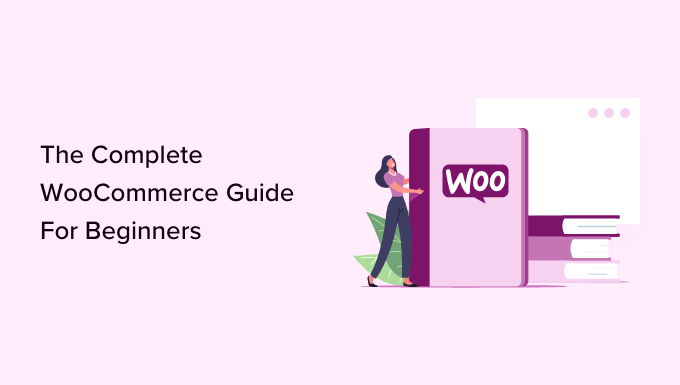
WooCommerce Tutorial (Overview)
Here is an overview of all the topics we’ll cover in this ultimate WooCommerce guide.
- What is WooCommerce?
- WooCommerce Review + Comparison with other eCommerce Platforms
- What Do You Need to Make a WooCommerce Store?
- Step 1. Getting Started with WooCommerce
- Step 2. Setting up WooCommerce and WordPress
- Step 3. How to Properly Install WooCommerce
- Step 4. Setting up Your WooCommerce Store
- Step 5. Choosing a WooCommerce Template & Theme
- Step 5. Installing WooCommerce Extensions and Add-ons
- Step 6. Resources to Grow WooCommerce Store
- WooCommerce Frequently Asked Questions
Ready? Let’s go create your store.
Video Tutorial
If you’d prefer written instructions, just keep reading.
What is WooCommerce?
WooCommerce is a free eCommerce software that makes it easy for selling products and services online. Over the years, it has become the most popular eCommerce platform in the world used by millions of small and large businesses (online stores).
WooCommerce is developed as an extension of WordPress which is the most popular website builder on the market. This allows users to build an eCommerce website from scratch or add shopping cart functionality to an existing WordPress website.
As open-source software, WooCommerce is free to download and use. However, while the WooCommerce software is free, you still need a domain name and web hosting service to set up a website, which costs money. We will talk more about WooCommerce pricing later in this article.
WooCommerce Review + Pros and Cons Comparison
WooCommerce has become the most popular eCommerce software in the world, with 6.6 million users, because it’s easy to use for beginners, and it comes with extremely powerful features.
Since WooCommerce is open source, not only is it 100% free, but you also get complete freedom and control over your eCommerce website.
Unlike other proprietary eCommerce platforms, WooCommerce pricing does not include licensing fees. This means you can use it to create as many online stores and eCommerce websites as you like.
WooCommerce is an eCommerce plugin built on top of WordPress, which means you get to benefit from all the powerful features of a WordPress site as well. See our complete WordPress review to learn more about WordPress.
There are thousands of beautiful WooCommerce designs and templates that you can choose from to start your online store. Each of them comes with easy-to-use customization options and many of them are available for free.
One of the main reasons why business owners love WooCommerce is its flexibility. You can add additional features to WooCommerce by using various WooCommerce plugins (also known as add-ons). There are literally thousands of WooCommerce-specific plugins that you can use to extend its functionality to add features like booking, subscriptions, shipping platform integrations, sales tax collection, etc.
Apart from addons made specifically for WooCommerce, you can also use thousands of WordPress plugins on your website to add features like contact forms, call now buttons, galleries, data backup, security firewall, etc.
Another advantage of using WooCommerce is that it puts no restrictions on how you run your business.
You can add unlimited products, make unlimited sales, import and export product data, add unlimited product images, videos, categories, and more.
Accepting payments online is a major hurdle for many users. For those users, the most important benefit of using WooCommerce is that it integrates seamlessly with dozens of payment services and gateways.
By default, it supports PayPal and Stripe out of the box. You can use dozens of other payment gateways through add-ons. There are even integrations available for some lesser-known and regional payment gateways.
Want to see how WooCommerce compares against other popular eCommerce platforms? See the following comparisons to check out how it stacks up against the competition.
That being said, now let’s take a look at what you need to make a WooCommerce-powered online store.
What Do You Need to Make a WooCommerce Store?
You will need the following three items to make a WooCommerce website from scratch.
- A WordPress hosting account. This is where all your website files will be stored.
- A domain name. This is your website’s address on the internet e.g. wpbeginner.com
- A SSL Certificate to securely accept online payments
The above items are not free and cost money. Often beginners ask, if WooCommerce is free, then why do I need to pay for these things.
Well, you need to pay for these three things to build any type of website (not just WooCommerce).
The overall cost of your online store (WooCommerce pricing) will depend on which services you choose to purchase for your website. You can easily control the costs by only purchasing what you actually need.
Remember, you can add other things later as your business starts making money.
Normally, web hosting would cost you $7.99 / month for a starter site, domain name $14.99 per year, and an SSL certificate around $69.99 per year.
Now, this is a significant investment, and every penny counts when you are starting a new business.
Luckily, Bluehost, an official WooCommerce and WordPress recommended hosting provider, has agreed to offer WPBeginner readers an exclusive discount on web hosting with a free domain name and SSL. Basically, you’ll be able to start for $2.75 per month.
→ Click Here to Claim This Exclusive Bluehost Offer ←
Bluehost is one of the biggest hosting companies in the world. They host millions of websites on the internet along with many of our own.
Now that we have covered the basic WooCommerce requirements, let’s see how to set up WooCommerce with step-by-step instructions.
Step 1. Getting Started with WooCommerce
First, you need to visit the Bluehost website and click on the ‘Get Started Now’ button.
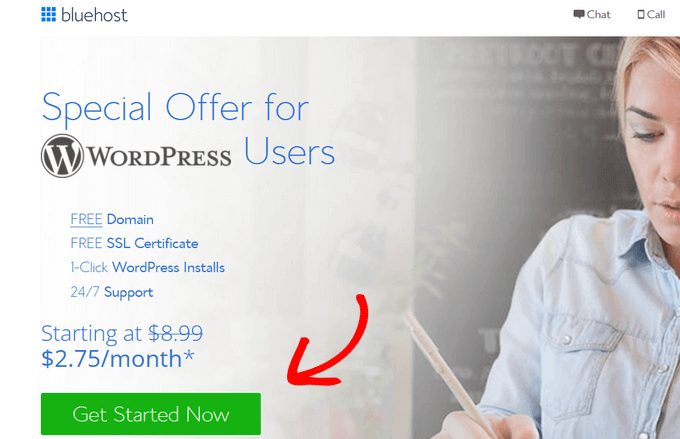
Next, you will be asked to select a plan for your hosting account. Basic and Plus plans are popular among many users, and remember you can always upgrade to get more resources later when you need them.
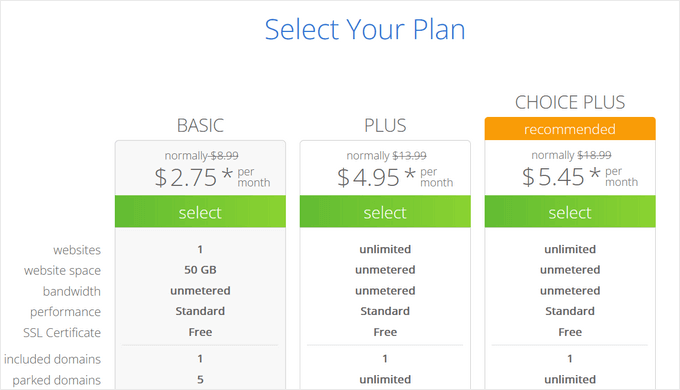
Click to select a plan and continue.
After that, you will be asked to register a new domain name or use an existing domain name that you already own.
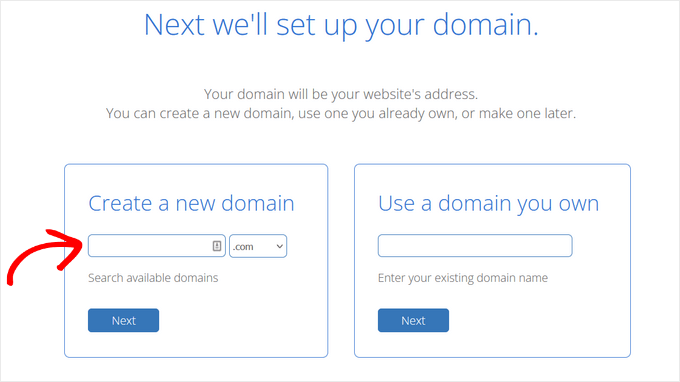
Here are some quick tips on choosing the perfect domain name for your WooCommerce store.
- Use keywords in your domain name. For example, if you want to sell gardening supplies then use it in your domain name as keyword.
- Use your brand name in your domain name
- Stick to .com extension
- Do not use numbers or hyphens in your domain name. This makes them hard to pronounce and spell
For more tips, see our guide on how to choose the perfect domain name for your business. You can even use a domain name generator to help.
It is important to spend time choosing the right domain name for your business, but don’t overthink it otherwise you will never get beyond this step.
Once you have chosen a domain name, click on the next button to continue.
Now, you will be asked to provide account information and finalize the plan details. Under the package information section, we recommend choosing the 36 months plan because that’s the best value.

Below that you will see optional extras. We recommend unchecking all of them as they will increase your costs. You can always add them later from your hosting dashboard when needed.
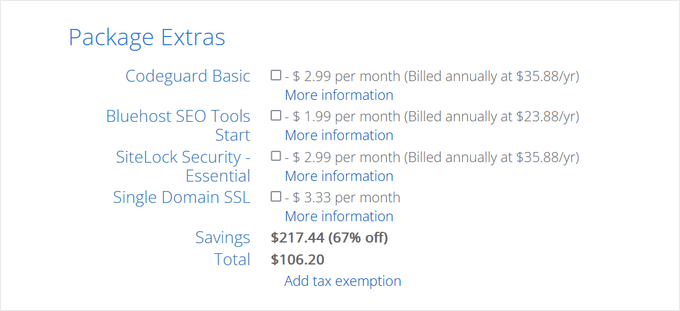
After that, fill in your credit card information and click on the submit button to complete the purchase.
Once you have made the payment, Bluehost will send you an email with details to log in to your web hosting dashboard. The dashboard is where you’ll manage your website.
Step 2. Setting up WooCommerce and WordPress
Most web hosting companies also offer 1-click WordPress installation. If you are using any other hosting company, then see our step-by-step guide on how to install WordPress.
Bluehost will automatically install WordPress for you when you sign up for a hosting account. You can simply log in to your hosting dashboard and click on the ‘Log into WordPress’ button.
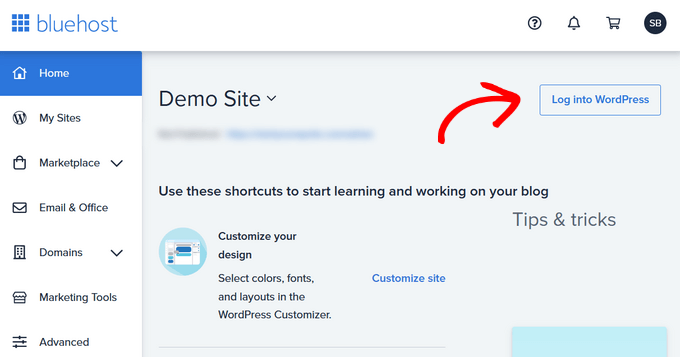
You can always use this shortcut as your WooCommerce login without entering a password.
You will now see the WordPress dashboard.

Now before we install WooCommerce, let’s first set up basic WordPress settings.
Go to the Settings page in the WordPress admin area and change your website’s title and optionally provide a tagline (description).
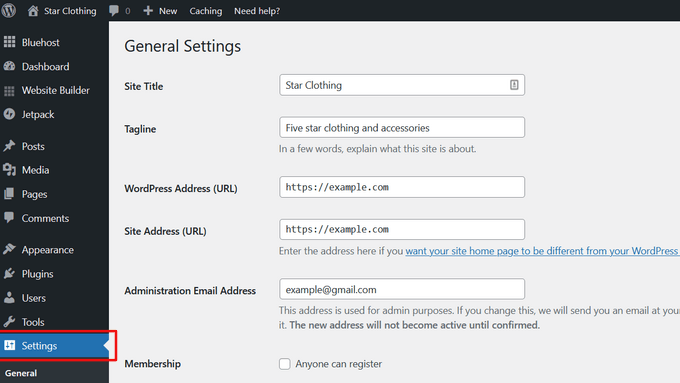
Bluehost will automatically install an SSL certificate for your domain name. Make sure that your website URL is showing https and not http.
If it is showing http, then you need to see our tutorial on how to enable free SSL in WordPress.
Next, you need to review the website admin email address. This email address is where you will receive WooCommerce notifications and password reset requests so make sure that it is correct.
After that, scroll down a little and select the timezone settings for your website.
Now, you can review all the settings once again and click on the ‘Save changes’ button to save them.
Once done, you’re now ready to install WooCommerce.
Step 3. How to Properly Install WooCommerce
WooCommerce is a WordPress plugin, so the installation process is similar to any other WordPress plugin. You can follow our step-by-step guide on how to install a WordPress plugin.
Simply visit Plugins » Add New page in your WordPress admin and search for WooCommerce. WordPress will now show plugin search results. You need to click on the ‘Install Now’ button next to WooCommerce.
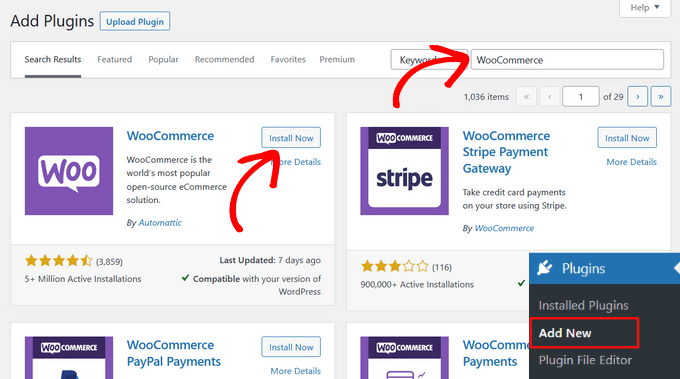
WordPress will now grab the plugin files and install WooCommerce for you.
Once finished, you need to click on the ‘Activate’ button to start using it.
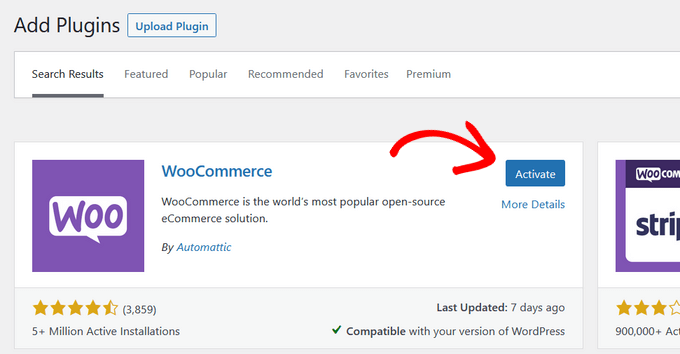
After activation, WooCommerce will launch the WooCommerce setup wizard.
First, you will need to enter your store location. After that, click on the ‘Continue’ button.
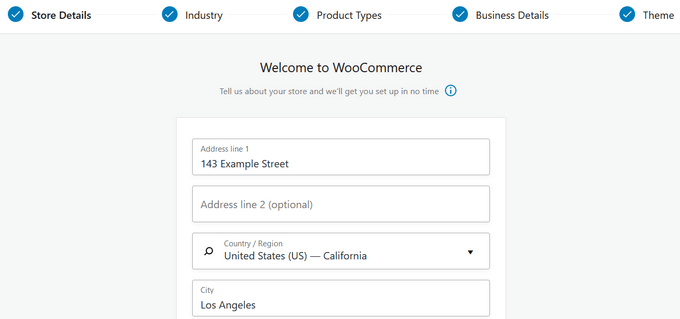
In the next steps, you need to select your industry, product type, and other business details.
The setup wizard will also ask you if you want to add recommended business features to your store. These features are free so you can choose to install them and click the ‘Continue’ button.
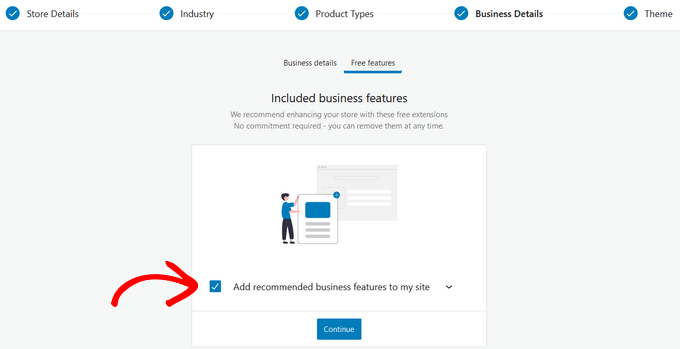
In the last step, you have the option to choose a new WordPress theme or continue with your active theme.
We recommend that you continue with your current theme for now because you can change your theme at any time. We’ll also recommend the best WooCommerce themes you can use later in this article.
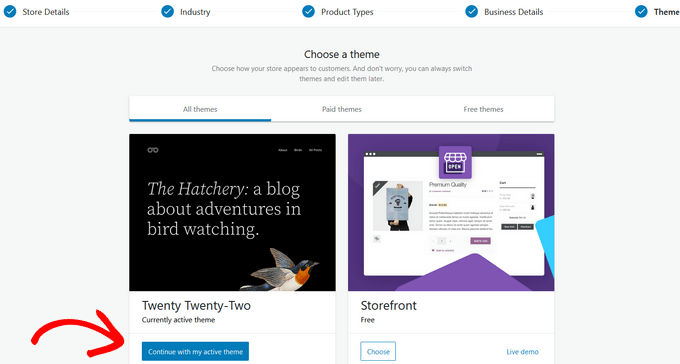
Once you click the ‘Continue with my active theme’ button, the setup wizard will save all of your WooCommerce settings.
Then, you’ll be redirected to the WooCommerce dashboard on your site where you can finish setting up your store.
Step 4. Setting up Your WooCommerce Store
In the WooCommerce dashboard, you’ll see a checklist of steps you need to take to customize your online store.
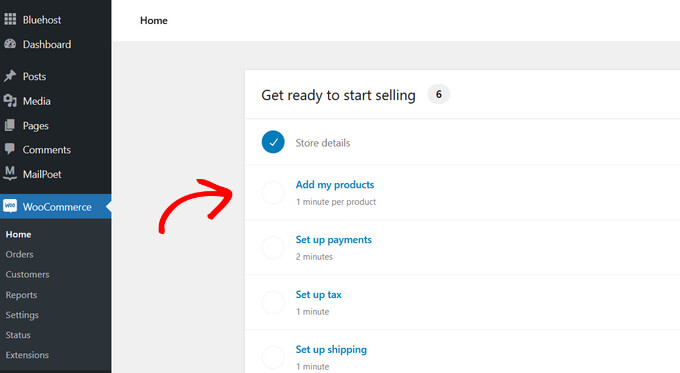
Start by selecting the ‘Add my products’ task.
Adding Products in WooCommerce
WooCommerce makes it really easy to add products to your store. You can add your first product with a template, manually, import via CSV, or import from another service.
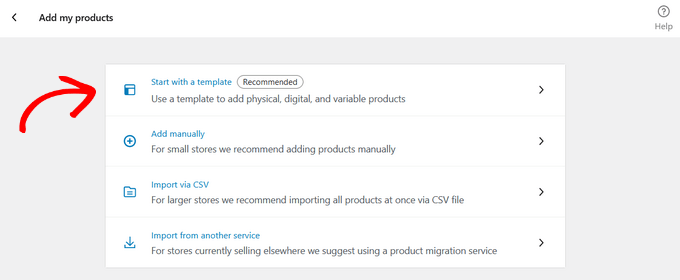
For this tutorial, we’ll show you how to add a product with a template.
Next, you can select a template for a physical product, digital product, or variable product.
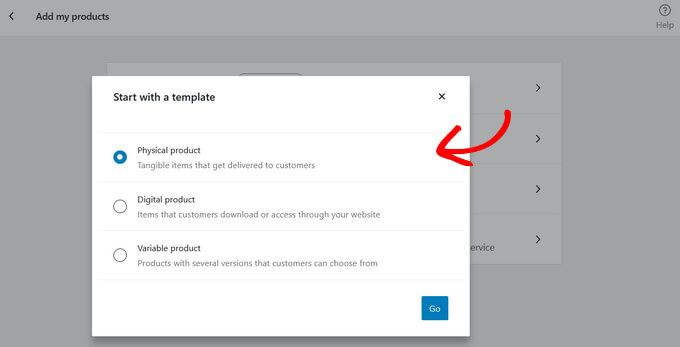
Once you click the ‘Go’ button, you’ll be taken to the product editor. Alternatively, you can add new products by going to the Products » Add New page from your WordPress menu.
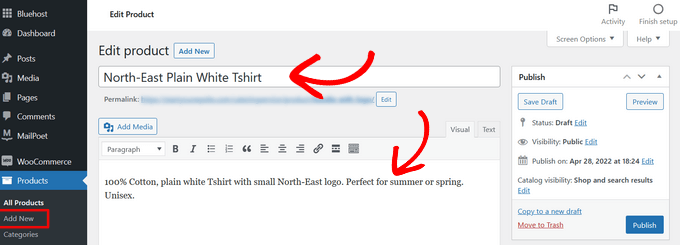
First, you need to provide a title for your product and then a detailed description.
After that, click on the ‘Add new category’ link in the right column. You can create a new category for the product you are adding.
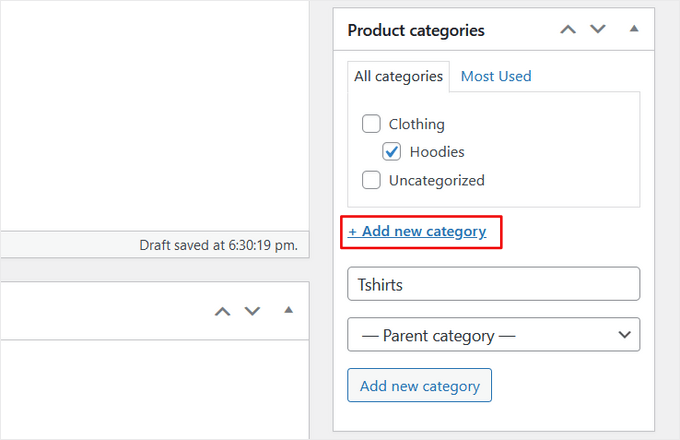
Product categories allow your customers to easily browse products on your website.
After that, you need to scroll down a little to the ‘Product Data’ box. This is where you will select the product type, add product pricing, shipping costs, grouped products, and other information.
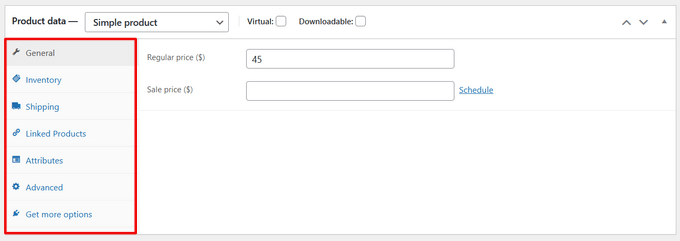
Next, you will see a product short description box. This description will be used on different product pages on your website. You need to add a catchy and informative short description that helps you get more clicks.
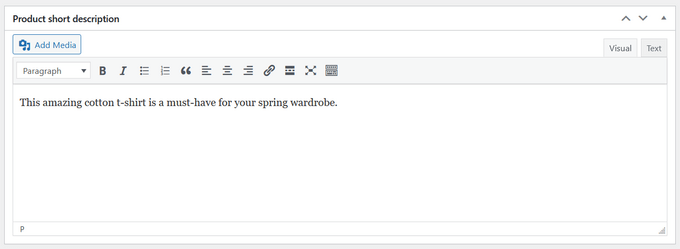
Nothing makes a product page more useful than product images. WooCommerce makes it super simple to add product images and even product image galleries to go along with each product.
First, you need to add the main product image. This will be the main product image that’s used on the shop pages across your store.
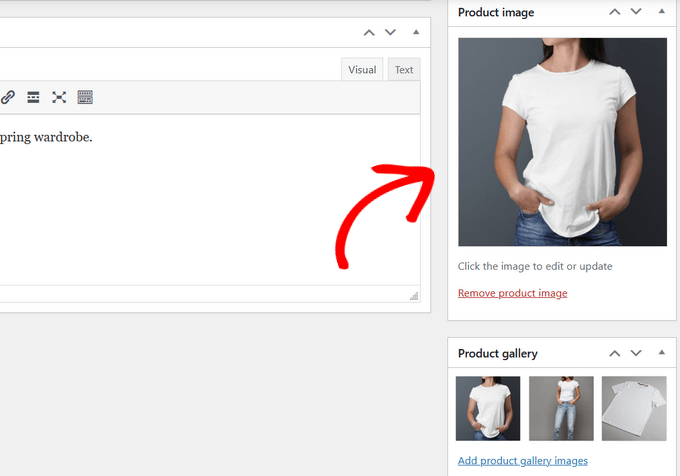
Below that you can add multiple images to create a product image gallery.
Now review all the product information that you have added so far. If everything looks alright, then you are ready to make this product live on your store.
Click on the ‘Publish’ button at the top right box on the screen to publish your product.
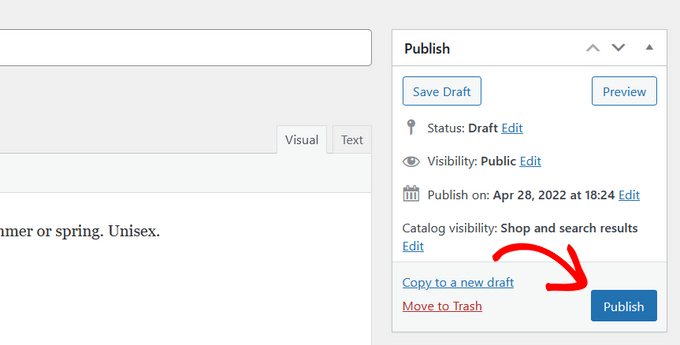
You can now repeat the process to add more products to your website.
Setting up Payments in WooCommerce
Next, you need to add payment options so customers can buy your products online.
Go back to the WooCommerce » Home page to see the WooCommerce setup checklist. Click the ‘Set up payments’ option.
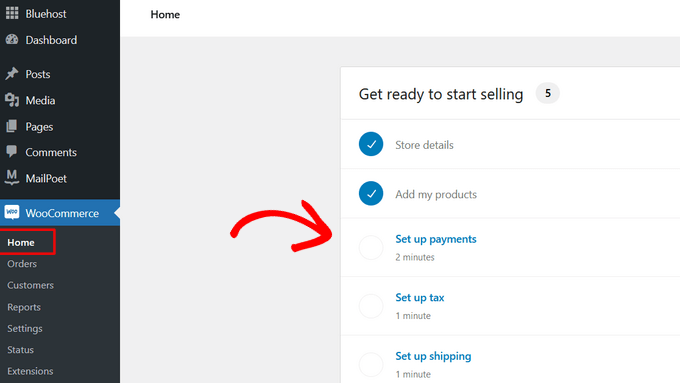
This will open up a page with a list of the payment processors you can connect to. You can choose from Stripe, PayPal, Klarna, and even direct bank transfer or cash on delivery.
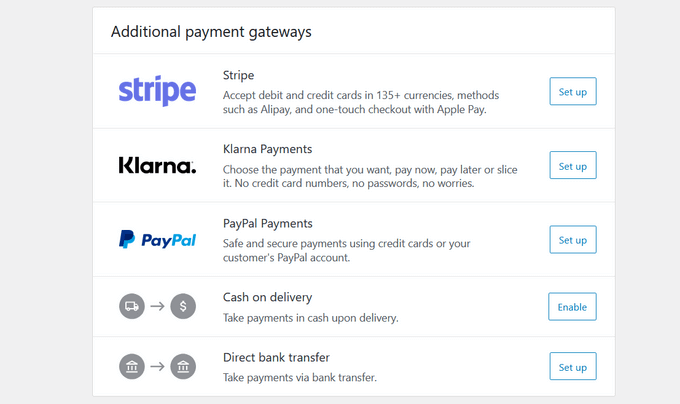
Select the one you want and follow the easy on-screen instructions to set up the payment gateway.
If you want to add a new payment method in the future, you can go to the WooCommerce » Settings » Payments tab.
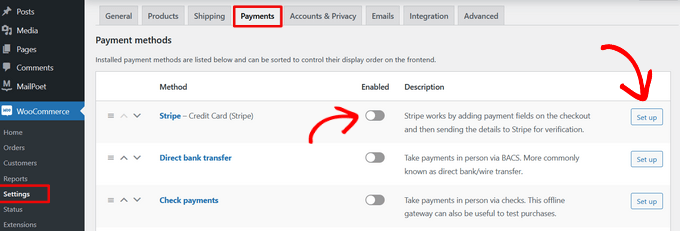
Note: While you can use WooCommerce’s default Stripe addon, we recommend using the free Stripe Payment Gateway for WooCommerce plugin instead. It comes with extra features like an easy setup wizard, one-click express payments via Apple and Google Pay, and more.
Next, we’ll show you how to configure your tax rates.
Setting up Tax in WooCommerce
On the WooCommerce home page, the next step in the setup guide is to set up tax.
You can set up taxes with WooCommerce Tax, Avalara, or you can set them up manually. You can also select the ‘I don’t charge sales tax’ option if you don’t add taxes.
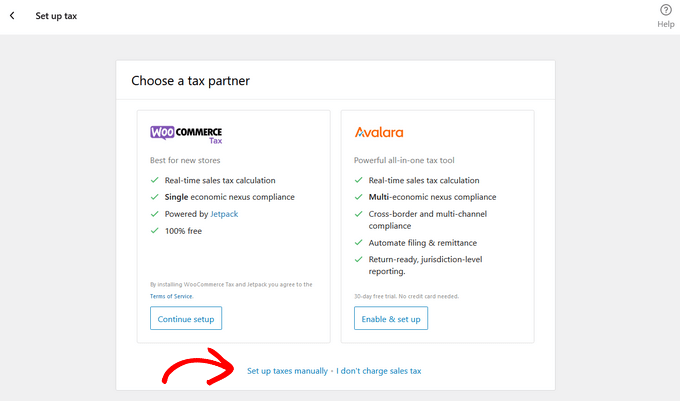
For this tutorial, we’ll show you how to set up taxes manually.
After choosing the manual option, you’ll be redirected to the WooCommerce » Settings » Tax tab.
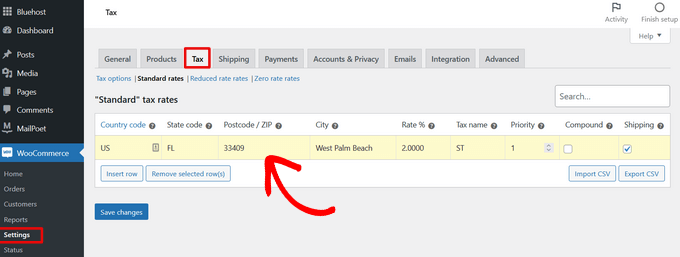
Simply enter your tax details like the country, state, city, and zip code. Then, enter the tax rate and tax name like sales tax or GST.
Don’t forget to click the ‘Save changes’ button to save your tax details.
Setting up Shipping in WooCommerce
Next, you can add shipping options by going back to the WooCommerce setup guide and clicking on the ‘Set up shipping’ task.
On this page, you can enter the shipping costs within your country or you can leave the price at zero to offer free shipping. You can also set up shipping classes to offer different rates for different types of products.
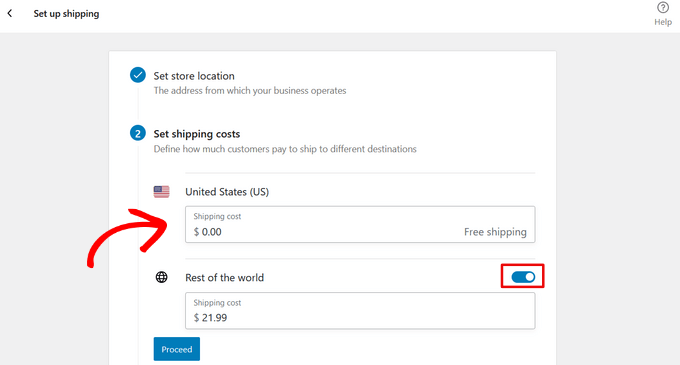
If you’re planning to ship to other countries, you can enable the ‘Rest of the world option’ and enter the costs for different shipping zones.
Once you’ve entered your shipping prices, click the ‘Proceed’ button.
Next, you can choose to install and enable WooCommerce Shipping to save time by printing shipping labels at home. Or, click ‘No thanks’ if you don’t need that feature.

Now that you’re finished setting up WooCommerce, let’s take a look at how you can further customize your store.
Step 5. Choosing a WooCommerce Template & Theme
There are thousands of online stores competing to sell similar products. Choosing a professional design for your store makes a big difference in how customers see your brand.
There are thousands of WooCommerce templates and themes available on the market. While you can use WooCommerce with any WordPress theme, we recommend choosing a WooCommerce-ready theme.
These themes are made specifically for WooCommerce websites, and they will help you make more sales on your website.
Since there are thousands of paid and free WooCommerce themes on the market, this abundance of choices can make it difficult for beginners to choose the perfect design.
To make this easier, we have hand-picked the best WooCommerce-ready themes that you can use. All of these are mobile-friendly and highly optimized for SEO and performance.
- Astra – One of the top WooCommerce ready WordPress themes on the market. Astra comes with full WooCommerce support, built-in templates for product and shop pages, and dozens of 1-click ready-made websites.
- Ocean WP – One of the most easily customizable theme for WooCommerce users.
- Shoppe – A modern and highly customizable WooCommerce theme. It comes with its own page builder allowing you to easily create landing pages for your products and campaigns.
- Outfitter Pro – A modern, hip, and clean WooCommerce theme made specifically for clothing brands and stores.
Looking for more options? See our expert pick of the best WooCommerce themes for some excellent choices.
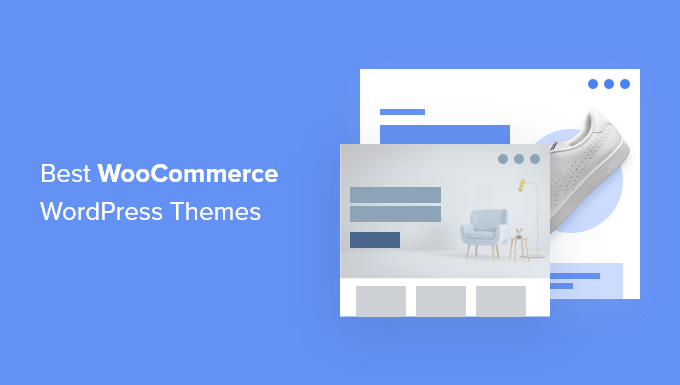
What to look for in a WooCommerce theme?
Looking at all these professionally made WooCommerce themes, you may be wondering how to choose the right theme for your business?
Following are just some basic tips that you can use as a guideline.
- Strive for simplicity in design. A simple and clean design helps customers focus on what’s important and improves conversions
- Test your selected theme on mobile. Most users access the internet from mobile devices so make sure that the theme you are choosing looks great on smaller screens.
- Only download themes from WordPress.org themes directory or reliable commercial theme shops. Themes from unreliable sources may have hidden malware which could ruin your business.
- Check reviews and ratings to avoid any red flags
For more tips, see our guide on how to select the perfect WordPress theme for your project.
Once you have chosen a WooCommerce theme, see our guide on how to install a WordPress theme to set it up.
Step 5. Installing WooCommerce Extensions and Add-ons
The real power of WooCommerce comes from powerful extensions and add-ons. These add-ons work exactly like a WordPress plugin, and you can install them like you would install any other WordPress plugin.
There are thousands of plugins available for both WooCommerce and WordPress. You can use them to create contact forms, make landing pages, add pricing tables, gift cards, and more.
Here are our top picks for must-have WooCommerce plugins for any eCommerce store.
- WPForms – Allows you to easily create contact forms, customer surveys, customer login forms, shipping calculators, and more.
- MonsterInsights – Allows you to install Google Analytics and track your top products, categories, and landing pages. See where your customers are coming from and what they do on your website.
- SeedProd – It’s the best drag and drop page builder plugin for WooCommerce. It allows you to easily create beautiful landing pages to promote products, marketing campaigns, sale events, and more. You can even use it to create a custom checkout page or make a custom WooCommerce theme without any coding knowledge.
- AIOSEO – All in One SEO is the best WordPress SEO plugin that’s used by over 3 million websites. It helps you optimize your store with the right WooCommerce SEO settings to rank higher in Google.
- FunnelKit – Helps you create sales funnels and customize WooCommerce checkout pages to add one-click upsells, order bumps, and other eCommerce automation to boost profits. It also comes with a marketing automation toolkit, FunnelKit Automations, that helps you set up email automation for WooCommerce.
- AffiliateWP – Lets you easily create an affiliate referral program for your WooCommerce store.
- Advanced Coupons for WooCommerce – Allows you to add custom coupons for free shipping, BOGO offers, and they also have extensions for loyalty programs, gift cards, and more.
- OptinMonster – Lets you create spin a wheel campaigns, floating bars, and other personalized popups to boost your sales conversion.
- TrustPulse – Allows you to utilize the power of social proof and FOMO to instantly win customer trust and generate more sales
- SearchWP – Helps you improve your WooCommerce product search by adding live AJAX search and more to boost sales.
- AdTribes – Lets you create WooCommerce product feeds for advertising platforms like Google Shopping, shopping networks, and comparison sites.
- RafflePress – Helps you run viral giveaway campaigns to promote your WooCommerce store.
- PushEngage – Allows you to connect with visitors after they leave your website through web push notifications. You can send notifications for cart abandonment, browse abandonment, price drops, and more.
- MalCare – Protect your customers’ information from hackers with a security plugin designed specifically for WordPress and WooCommerce sites.
For a more comprehensive list, see our expert pick of the best WooCommerce plugins that we recommend.
Note: You might see other guides recommending Jetpack plugin by Automattic, but we do not recommend it because it can bloat your site with unnecessary features.
Step 6. Resources to Grow WooCommerce Store
Now that your WooCommerce store is up and running, it is time to start promoting your WooCommerce store and grow your business.
Here are some resources that will help you learn WooCommerce and grow your online store like an experienced pro.
1. Start an Email List
More than 90% of people visiting your WooCommerce store will leave without making a purchase. Losing these users is like losing money.
This is why building an email list is extremely important for online store owners.
An email list allows you to give customers a chance to stay in touch with you without buying anything. This opens a direct line of communication between you and the customers, so you can then try and convince them to make a purchase.
See our guide on how to properly start an email newsletter for your WooCommerce store for details and step-by-step instructions.
The good part is that WooCommerce integrates with all major email marketing services in the world including Constant Contact, HubSpot, Brevo (Sendinblue), Drip, and thousands more.
2. Generate More Leads
Each user who subscribes to your email list is a potential lead/customer. This is why it’s best practice to offer website visitors multiple options to join your email list. This practice is called lead generation.
Most store owners make the mistake of only adding a basic email signup form to their store which hurts your overall conversion.
This is where OptinMonster can help. It is the best lead generation software in the world that allows you to easily convert abandoning website visitors into email subscribers and then paying customers.
For details, take a look at these tips on how to convert WooCommerce visitors into customers.
3. Track WooCommerce Users
Ecommerce stores need marketing data to make informed decisions. This data includes where your visitors are coming from, which products are popular, which products are not doing so well, and more.
These insights help you make data-driven decisions and adjust your marketing strategy accordingly.
MonsterInsights helps you easily make sense of all this data using Google Analytics. It comes with enhanced eCommerce tracking which helps you unlock a treasure trove of helpful data with just a few clicks.
For instructions, see our guide on how to track WooCommerce customers in Google Analytics.
4. Learn WooCommerce SEO
SEO or Search Engine Optimization helps you get more visitors from search engines to your WooCommerce store.
WooCommerce itself is very SEO friendly out of the box, but there is so much more you can do.
Since most beginners find WooCommerce SEO a bit intimidating and technical, we have prepared a complete step-by-step WooCommerce SEO guide to help you properly utilize SEO without any expert help.
The shortcut is to use the AIOSEO plugin because it gives you everything you need to rank higher in SEO.
5. Recover Abandoned Cart Sales
Once a customer adds a product to their cart, there is a 60-80% chance that they will leave it without completing the purchase. That’s an average from all eCommerce websites, so it could be even higher.
Many eCommerce site owners don’t pay attention to this metric from the beginning and that’s pretty much leaving money on the table.
We have compiled a cheat sheet to easily recover WooCommerce abandoned cart sales. This will give you a good head start and will help improve your overall sales.
Hopefully, these resources will help you improve your WooCommerce store and grow your business.
WooCommerce Frequently Asked Questions
WooCommerce is an incredibly powerful platform, and often business owners have many WooCommerce questions before getting started.
Having helped thousands of beginners start with WooCommerce, we have heard a lot of them. Here are some of the most frequently asked WooCommerce questions from our users.
1. Where can I see a live WooCommerce demo?
WooCommerce is used by millions of websites. Chances are that you have already visited many WooCommerce-powered websites without even noticing it.
It is not just used by small businesses, WooCommerce is actually used by some of the world’s top brands as well.
Here are some of our favorite examples of WooCommerce demos in action.
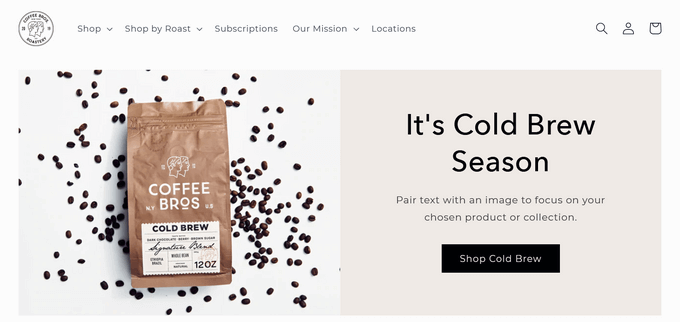
A clean and simple WooCommerce powered store selling classic and premium coffee blends.

Badeloft, a luxury bathroom fixture retailer, uses WooCommerce for its online store.

Popular gardening equipment brand Gilmour uses WooCommerce to sell products online. Their website is a balanced combination of functionality and simple design.

Flwr is a small floral design studio based in New Zealand. Their website features a simple and elegant design with a beautiful background and a highly customized shop page.
2. What Kind of Products I can sell with WooCommerce?
You can sell all types of products with WooCommerce. Whether they are physical goods (products that require shipping), downloadable products (ebooks, software, digital art), or even subscriptions and memberships.
WooCommerce has extensions that allow you to use it as a booking platform, auction site, multi-vendor marketplace, dropshipping, and so much more.
3. What are some WooCommerce alternatives?
WooCommerce is flexible and easy to use, but it may not always be the right solution. Depending on your needs, you may find some other solutions more suitable. See our list of best WooCommerce alternatives for more examples.
4. Can I use WooCommerce for Dropshipping?
Yes, you can. In fact, WooCommerce is the #1 choice to make a dropshipping website. There are several excellent WooCommerce dropshipping plugins that allow you to easily handle orders, manage vendors, and automate the whole process.
For step-by-step instructions, see our complete dropshipping guide for beginners.
5. Can I add a blog in WooCommerce?
Yes, you can. Your WooCommerce store runs on top of WordPress which is already the best blogging platform in the world. All you need to do is create a separate blog section and start writing posts.
6. Can I change my WooCommerce store name?
You can change your store name by visiting the Settings » General page in the WordPress admin area. Simply change the title to whatever you want to call your store.
However, if you want to change the domain name of your WooCommerce store, then that’s a slightly different process. See our tutorial on how to move WordPress to a new domain name without losing SEO.
7. Where is my WooCommerce login information?
You don’t have a separate WooCommerce login for the admin area because WooCommerce is a WordPress plugin. To login to your WordPress dashboard, simply use the WordPress login link.
However your customers will have a WooCommerce login, so they can log in to their account area to keep track of orders. You can see our step-by-step guide on how to create custom login forms for WordPress.
8. How can I get WooCommerce support?
Since WooCommerce is a free software, there is limited WooCommerce support available through WordPress community forums as well as the official WooCommerce website.
The majority of WooCommerce support is provided by your WooCommerce hosting provider or the individual WooCommerce theme and extension developers.
For custom WooCommerce development and customization work, you can hire a WordPress developer from a trusted WordPress services provider like WPBeginner Pro Services.
That’s all, we hope this WooCommerce tutorial helped you learn how to set up WooCommerce and make an eCommerce store. You may also want to see our guides on creating a free business email address and the best business phone service.
If you liked this article, then please subscribe to our YouTube Channel for WordPress video tutorials. You can also find us on Twitter and Facebook.





Syed Balkhi says
Hey WPBeginner readers,
Did you know you can win exciting prizes by commenting on WPBeginner?
Every month, our top blog commenters will win HUGE rewards, including premium WordPress plugin licenses and cash prizes.
You can get more details about the contest from here.
Start sharing your thoughts below to stand a chance to win!
Mrteesurez says
Fantastic, this article is detailed enough and provided all information needed to setup a standard woocomerce store.
Is there anyway change the slug of the “shop” page to another ??
And also, how to I remove some endpoint in a woocomerce account page and add custom tab in the account page ??
WPBeginner Support says
You can change the page and slug for your shop page under Woocommerce > Settings > Products tab. For changing endpoints and customizing it, you would want to check with WooCommerce’s documentation and support.
Admin
Jiří Vaněk says
Thank you very much for the articles. For 2024, I have made it my mission to finally learn how to work with Woocommerce, because it is still a part of WordPress that I have never worked with and unfortunately I miss many of the basics. This article is great to start with before I move on to more details.
WPBeginner Support says
Glad we could be helpful
Admin
Enricka Julien says
I found this tutorial on setting up a WooCommerce store as a newcomer to eCommerce to be incredibly helpful. The step-by-step approach made it much easier to understand the complexities of eCommerce. The additional resources provided a deeper dive into specific areas of interest. Thank you for demystifying WooCommerce and making it accessible for beginners like myself! I am excited about more content like this.
By the way, I was wondering if you have any tutorials or blog posts on creating a table of contents linked to a specific paragraph, as I have noticed in this blog post and a few others?
WPBeginner Support says
Glad you found our article helpful, for a table of contents guide we would recommend our article below:
https://www.wpbeginner.com/plugins/how-to-create-a-table-of-content-in-wordpress-posts-and-pages/
Admin
Donald Garber says
It seems that WooCommerce and PayPal have parted ways. WooCommerce doesn’t offer PayPal as a payment option within this plug in. Might have to add another paypal plugin?
WPBeginner Support says
There may have been a change recently but WooCommerce normally offers plugins to add functionality from their site itself to regain the ability to use it
Admin
ALAN says
HI GUYS, Thanks so much for this guide. This was the first website that popped up in my search results! Very good. Greetings from holland
WPBeginner Support says
You’re welcome, glad our guide is ranking well and is able to help you!
Admin
Lisa says
Just wanted to say that I have found your site so useful and informative in setting up my own website. I have come to recognize and trust your website above all else. Thank you for sharing easy to follow & reliable info!
WPBeginner Support says
You’re welcome, glad you found our content helpful!
Admin
JD says
Was wondering if I should install a WP Theme or a Woo Commerce theme? I just am setting up a simple site to sell prints of my photographs. im assuming I just install a Woo Commerce theme.
thanks.
WPBeginner Support says
You can install either of those, a WooCommerce theme is mainly a theme designed with WooCommerce in mind. You can use a non-WooCommerce theme and it could work just as well if you prefer the design of one over the other.
Admin
Anderson Bishop says
You should remove coffeebros off this article they are now powered by Shopify.
WPBeginner Support says
Thank you for letting us know, we will be sure to look into that when we update the article!
Admin
Paula says
Can you use woocommerce for keeping track of inventory?
WPBeginner Support says
Yes, you can set up inventory for your products on WooCommerce.
Admin
amy says
What I am looking for is an explanation of how to add Paypal to WooCommerce.
WPBeginner Support says
That is covered in step 3 and something that is a part of WooCommerce’s setup wizard or you can set it up under WooCommerce>Settings>Payments.
Admin
Tanya says
Can you use WooCommerce with a GoDaddy Domain
WPBeginner Support says
It seems like you may have some confusion, for a starting point you may want to take a look at our article below:
https://www.wpbeginner.com/beginners-guide/whats-the-difference-between-domain-name-and-web-hosting-explained/
Admin
ALEJANDRO says
I want to become an expert on working with woocommerce. Thnx.
WPBeginner Support says
Glad our guide can give you a starting point
Admin
Edward T Price says
Some of the products I sell have restrictions on shipping to various states. Is there a way to add these restrictions for certain products and have it automatically cancel an order if the shipping address is restricted?
WPBeginner Support says
You would want to check with WooCommerce for if that is currently an option, otherwise you would need to add a plugin for that functionality
Admin
Anita says
Thank you for these detailed guide, my fear of WooCommerce just disappeared.
WPBeginner Support says
Glad our guide was helpful
Admin
Grant Mathis says
Really helpful article, on a really helpful site – I’m starting up (yesterday) and have lots to learn – thanks for the start!
WPBeginner Support says
You’re welcome, glad our guides can be helpful
Admin
Guru Aum Jah says
Given my personal experience with Jetpack causing problems with jump-links on my website, i was delighted when I read in this article that I could use other add on plugins instead of Jetpack.
The article stated that those other options would be listed below, but I could not discern which of anything listed were pertaining to whatever it is that Jetpack was supposed to be doing. As I write this, it is all compound by not knowing what we needed from Jetpack in the first place.
WPBeginner Support says
The plugins we cover as alternatives are in Step 5 Installing WooCommerce Extensions and Add-ons
Admin
Ani says
Thanks. I really appreciate the info given here.
I would like to get those kinds of icon you have at “I need help with…….” For my site
WPBeginner Support says
To see how they are set up, you would want to take a look at our inspect element article here: https://www.wpbeginner.com/wp-tutorials/basics-of-inspect-element-with-your-wordpress-site/
Admin